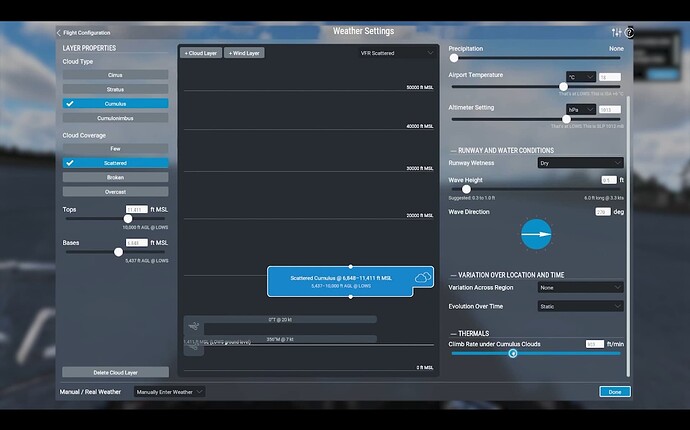Any ‘weather related’ development is promising but for ‘thermals’ it’s crucial to distinguish between:
-
air going up (or down) as it moves over a slope.
-
air moving up and down totally unrelated to the clouds
-
air moving mostly up under likely-looking Cu or CuNim clouds (with the latter sometimes having air moving violently down)
-
Hard-coded design to put vertically-moving air in certain locations.
MSFS does a passable job at (1) but it really is just the first five lines of code, i.e. lift is simulated if the plane is above a wind-facing slope but the formula applied (lift rising to 20,000 feet from a 200-foot slope) isn’t ideal. There’s a trick we use to work around that by setting weather ‘AGL’ and killing the wind above something like 1500 feet AGL. FWIW it is trivially simple to radically improve the simulation by sampling maybe 5 points below the plane instead of just one and having a better ‘lift AGL formula’, but again the rookie error is to think a pivot from a single sample to a full-scale CFD is the answer (it never is).
For ‘thermals’ (i.e. 2,3,4) the rookie error in flightsims is to lean heavily on (2) and hope sim pilots don’t know the difference, and that’s mostly what we currently have in MSFS (we call it ‘ground lift’ as the lift is mapped to the ground surface type e.g. urban vs desert rather than the clouds).
To Asobo’s credit they have added lift under some of the clouds i.e. (3), but it’s not common and offset somewhat from the cloud. But it’s very much a step in the right direction.
So for Thermals Up & Downdrafts the MOST important thing is to have the vertical air movement pretty much derived from the cloud map (assuming Cu clouds). Hopefully one day we’ll get this.
IF we have thermals/clouds connected, then it’ll make sense to think about what else could be done for vertical air movement.
The most common incremental effect is ‘streeting’, i.e. the action of thermals forming under Cu’s on a windy day can have the effect of those thermals (and hence the CLOUDS) forming ‘streets’ - these are quite important for soaring as you can follow a ‘street’ and make good progress into-wind that otherwise would be difficult.
I’d suggest the next thing after ‘streeting’ would be ‘wave’, i.e. on a windy day with a ‘stable’ atmosphere, the air can form very widespread cross-wind ‘ripples’ with the air rising up and down. Often those rising areas of wind remain fixed over the geography, as the wave in the first place is triggered by some high ground upwind. Wave lift often causes stationary ‘lenticular’ clouds to form and for glider pilots soaring the front edge of those clouds is a bit like ridge soaring but without the rocks.
In a nutshell, it’d be nice to get some of these incremental features but linking the lift primarily to the clouds (in addition to the ridge lift) is the most important immersive feature.
